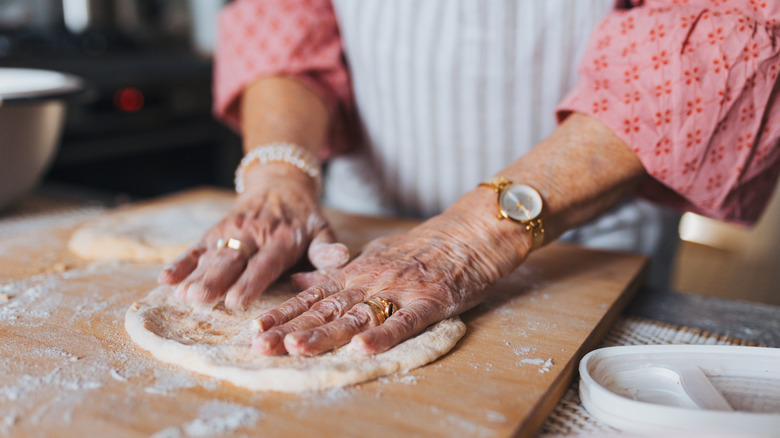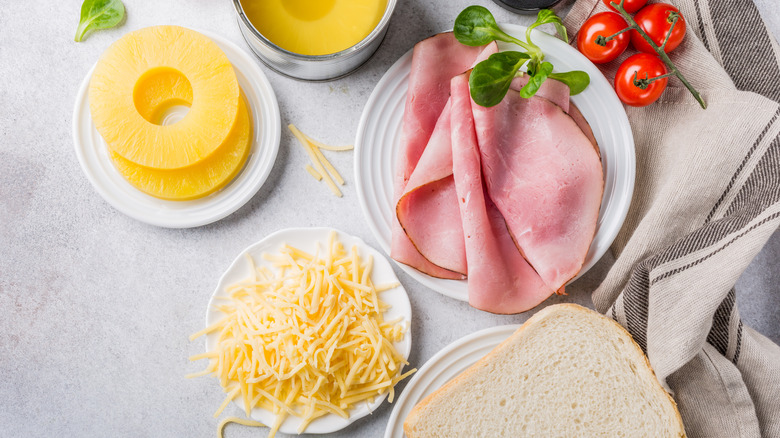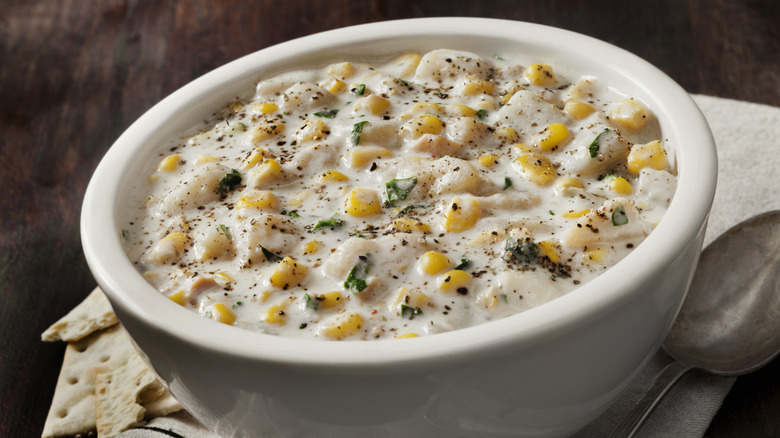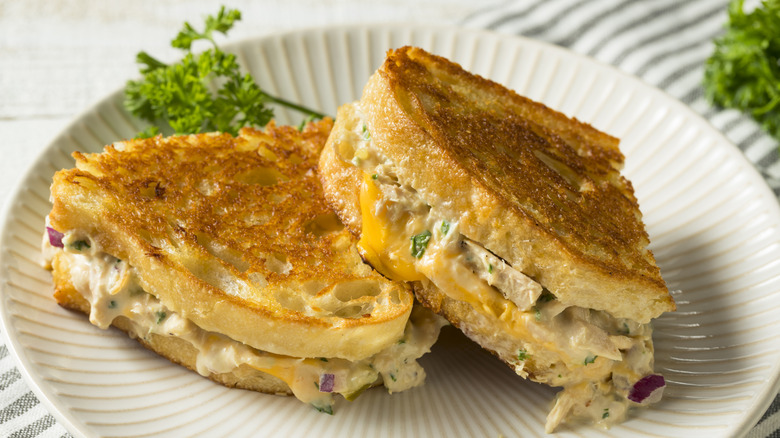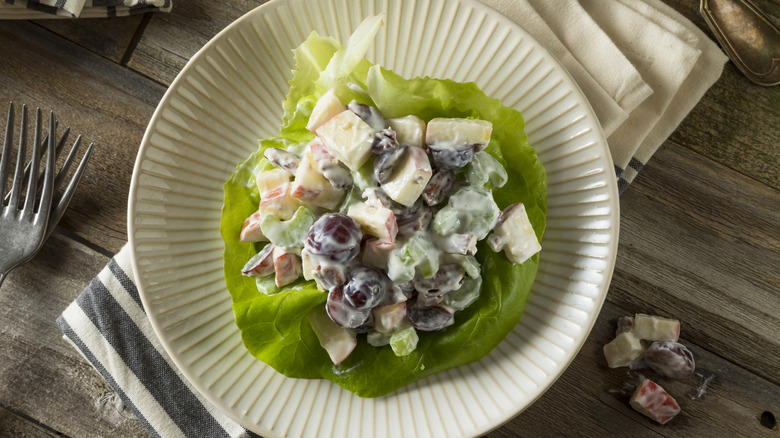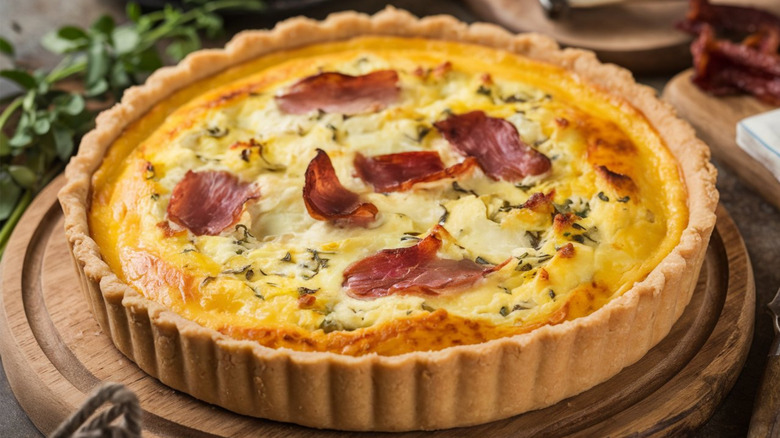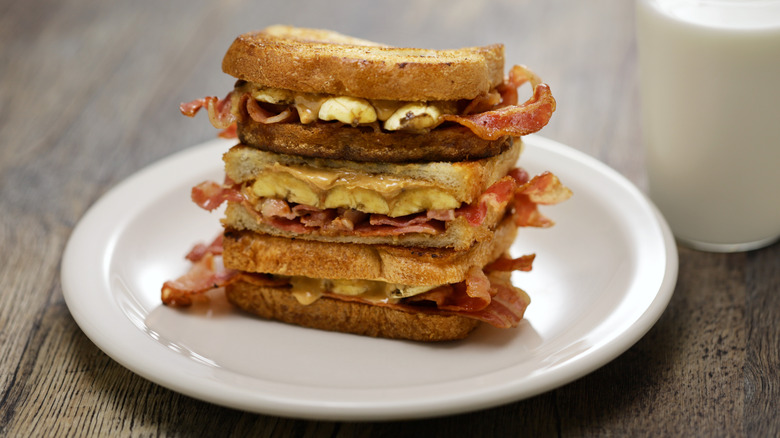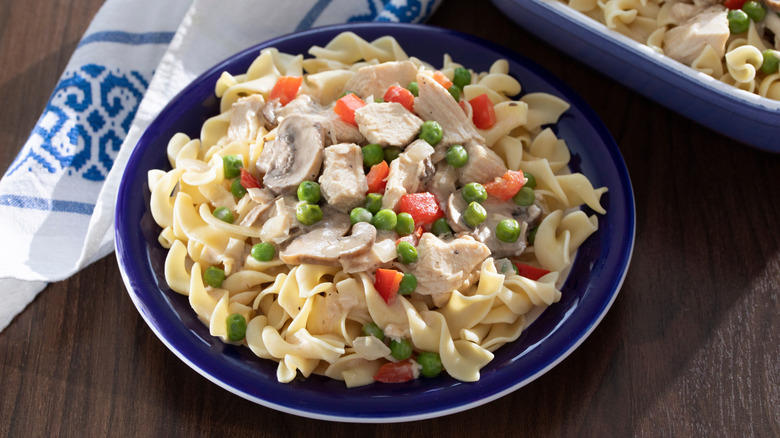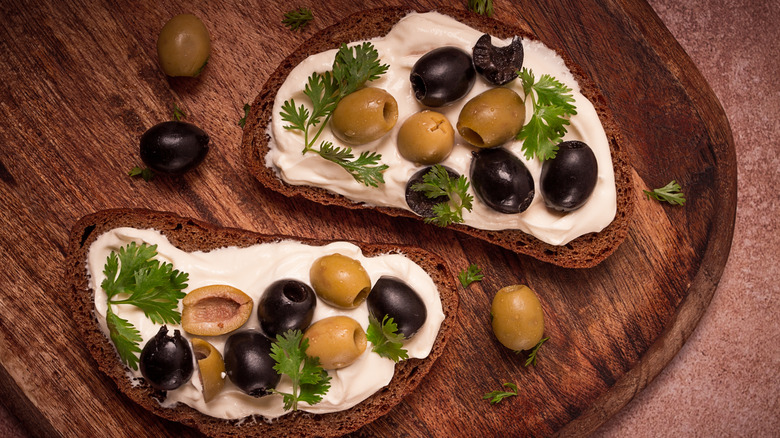10 Vintage Lunch Dishes Your Grandma Might've Made Every Week
Grandma's lunches are classics, salt-and-peppered with nostalgia. She could put together luncheon spreads with gusto, or just as expertly whip up quick meals from pantry staples if she wasn't expecting company. Some of these go-to lunches were creative ways to use up and reimagine leftovers, while others were popular trends back in the day that may have fallen out of favor, but are deserving of a taste test. A few of these retro combinations might seem strange today for their unfamiliar textures and unusual melange of sweet and savory. In any and all cases, though, Grandma's weekly lunch ideas were simple but elegant, and full of flavor.
Adding mayo to leftovers could go a long way if the goal is to simply whip up something filling and nutritious fairly quickly. The more elaborate dishes Grandma might have prepared for lunches, with family or friends, were tried and true recipes guaranteed to please a crowd. Though she surely had many of her own creations, she also likely had an arsenal of popular cookbooks for additional lunch ideas, with recipes she relied on and adapted to her own tastes. To prepare meals that were wholesome and tasty, Grandma's lunchtime cooking philosophy reminds us all that innovation is in the little things, imagination is key, and a little cream never hurt. Here's a list of 10 vintage lunch dishes that Grandma might have prepared every week.
1. Pineapple sandwich
A pairing that dates back to the end of the 19th century, the pineapple sandwich is a Southern classic. Made much easier by the invention of canned pineapple in the early 1900s, this combination was popularized long enough ago to have become a household staple by the time Grandma was preparing things in her kitchen. The Southern version of this recipe is as simple and refined as it gets — rings of canned pineapple on bread slices slathered with mayonnaise.
As with anything classic, infinite variations for this simple sandwich exist. While a mayo and pineapple filling might sound fit for a tea party, those who like a slightly more robust sandwich might prefer pineapple and ham as another tried and true variation (a nod to the Hawaiian pizza, which was first popularized in the 1960s). If Grandma wasn't in a rush to put together her pineapple sandwich, some midcentury cookbooks she might have had in her cupboard favor a slightly creamier version, opting for cream cheese instead of mayo. The 1954 Betty Crocker "Good and Easy Cook Book" suggests crushed pineapple mixed in with cream cheese and minced chives, served with watercress, for a well-rounded mix that still lets the pineapple shine through. Food editors at the monthly women's magazine "McCall's," popular through the 1960s, included a vegetarian-friendly option that still had a little protein in the 1963 "McCall's Cook Book," with the suggestion of mixing chopped walnuts or pecans in with the cream cheese.
2. Molded salad
The molded salad was something Grandma could put together with ease, following an age-old tradition of presenting meals in gelatin. The molded salads of Grandma's day were a more colorful version of aspic, a savory gelatin dish made of meat stock. Popularized in the early 19th century, aspic functioned as a means of preserving meat, using up leftovers, and presenting meals in a creative way, since ingredients such as meat or vegetables could be artfully arranged in the gelatin.
Gelatinous main courses made a comeback in Grandma's day, encouraged through recipes from popular cookbooks of the time, such as Irma S. Rombauer's "Joy of Cooking," which dedicated entire chapters to possible gelatin configurations. Molded salads could be very much like aspics, using unflavored gelatin and filled with meats or vegetables. But these artful meals also might employ the use of Jell-O, which had a moment in the 1950s and 1960s, serving as a status symbol by employing the latest in processed food technology. Often served on the sweet side, these salads did not shy from mixing sweet and savory ingredients, either. Betty Crocker's "Good and Easy Cook Book" suggests a Pacific Lime Mold, which toes the line, mixing cottage cheese and horseradish with crushed pineapple in a lime-flavored gelatin. But Dorothy B. Marsh's "Good Housekeeping Cook Book," dating back to the 1940s, suggests something more reliably sweet in her Frozen Ginger Ale Salad, made with canned fruits and, yes, ginger ale.
3. Salad Sandwiches
Tuna salad sandwiches have an intriguing history, but are part of a general trend towards sandwiches made from creative salad ideas. Dating back to the late 19th century, when women were finally allowed to frequent restaurants on their own, chicken, tuna, or crab salad were deemed suitably feminine choices to order, giving an early association as a "ladies' meal." Once women started joining the workforce, leisurely restaurant lunches transformed into quick stops at the lunch counter. This was when chicken or tuna salad was served between slices of bread so it could more conveniently be eaten on the go, and the salad sandwich has been a staple ever since.
Grandma likely whipped these up on the regular, mixing leftover meat with mayonnaise for a quick and hearty lunch the day after a chicken dinner. If she was feeling fancy, maybe she would have added grapes or celery to her chicken salad for some extra crunch à la Waldorf. Tuna salad would have been even easier to whip up if she needed to make something quick and had a can of tuna in the pantry. Some days, Grandma might have skipped the bread altogether and just prepared her chicken, tuna, or even egg salad on a bed of lettuce, for a lighter meal. Whether in salad or sandwich form, these quick and nourishing staples made for an easy and elegant lunch.
4. Chowder
A dish popularized in New England in the 18th century, Chowder is an umbrella term for a few kinds of pottage. There are many different types of chowder, and the name rarely means the same thing in the different places that claim it as a local dish. Even today, chowder recipes vary across regions, with some calling for cream and others a tomato base. Depending on where she grew up, Grandma may have preferred her chowder to be made with either corn or clams, among the myriad possible variations of these recipes, most popular in the Midwest and Northeast, respectively.
Though it's certainly guaranteed to be warm and heartening, Grandma's chowder needn't be reserved for winter days either. Corn chowder, specifically, was popularly deemed a go-to course for luncheon ideas any time of year in "The Good Housekeeping Cookbook," which remained a popular cooking manual from back in Grandma's day. Though a possible appetizer, if served in smaller portions, a heartier serving was fit to be a main course. No matter the occasion, Grandma's chowder was sure to be wholesome and nourishing.
5. Melts
Claims suggest that the tuna melt came to be as an accident in the 1960s, when a South Carolina cook discovered that some tuna salad had spilled and gotten mixed in with a grilled cheese in the process of being grilled. It may be more legend than truth, but the facts remain that combining the contents of a tuna salad and grilled cheese makes for one delicious sandwich. Grandma must have been on board when she wanted to dress up her tuna salad a bit, or make more than just a classic grilled cheese.
While the tuna melt is probably the most popular, this same concept is just as simple and delicious when grilling any other salad sandwich and topping it with melted cheese. Grandma might have preferred a chicken melt, ham melt, or even a crab melt. In any case, melts were certainly trending back in her day, and might even be enjoyed as open-faced sandwiches too. Betty Crocker, in her "Good and Easy Cook Book," was an advocate for the latter. One of her easy lunch recipes consists of an open-faced bacon and tomato sandwich, topped with a slice of cheese, then broiled — proof that the melt adds a little something special to even the humblest of sandwich ingredients.
6. Waldorf salad
The Waldorf salad was named for the hotel that first served it, at a debut event for the then-brand-new Waldorf Hotel in New York City in 1893. This original recipe was a simple but elegant combination of apples, celery, and mayonnaise. A success amongst the hotel's elite clientele, the dish was served at the Waldorf from then on, its name maintaining an association with upscale dining, which defied the simplicity of its composition. Equal parts sweet, savory, crunchy, and creamy, the Waldorf salad remained an assembly of ingredients that was easy enough to recreate, and it soon became a popular lunch dish at other eateries, its name always peppering the salad with a tinge of the luxurious.
A homemade Waldorf salad was certainly something Grandma would've had in her arsenal of go-to lunch recipes, whether she wanted to enjoy a light meal on her own or arrange a nice luncheon for friends or family. Her version of the salad might have been a bit different to the original three-ingredient recipe, as the salad's simplicity has inspired many restaurants and home chefs to get creative with it. She might have added grapes and walnuts to the mix, which are still two popular additions to the original base. If she was following the recipe in "Joy of Cooking," she might have supplemented walnuts with pecans, either option giving a little extra protein and crunch to make this salad even more interesting to munch on.
7. Quiche
The quiche, a popular dish typically attributed to the north of France, gained international popularity after WWII. It's possible that Allied soldiers got a taste for it while overseas. But the recipe certainly gained midcentury popularity thanks to Julia Child's co-written cookbook published in 1961, "Mastering the Art of French Cooking," which introduced Quiche Lorraine (among hundreds of other French classics) to an anglophone audience and suggested it as a luncheon dish. With eggs, crème fraîche, and bacon making up the principal ingredients, it's not hard to imagine why this delicious savory pie quickly enjoyed widespread popularity. While purists prefer no more than these three staple ingredients, the concept of the quiche is infinitely adaptable. It's also easy to make vegetarian by swapping meat for veggies in the filling — adding cheese makes it all the more decadent.
With base ingredients that provided a blank canvas for more creative additions, the quiche had a moment in Grandma's day. It was so popular, in fact, that a widespread quiche craze led to the dish being largely associated with ladies' lunches as a feminine food. Though it could be served fresh from the oven, it is even better served cold, as this allows the filling to set so the flavors can come through. Grandma's sure to have made a few quiches in her day, whether having guests over for lunch, organizing a picnic, or preparing something that could last for a few meals at home.
8. Peanut butter bacon sandwich
Among all the classic or creative sandwiches Grandma prepared, the peanut butter bacon one might be one of the more surprising combinations. While this flavor combo has had a moment in more recent history, and might be Katie Couric's favorite sandwich, it was just as popular in Grandma's day. The combination of peanut butter and bacon wasn't regarded as strange, either. This pairing was popular enough to feature in practically every mainstream midcentury cookbook.
Simple, protein-rich, and guaranteed to be delicious, this salt and fat combination need not be dressed up, but is ripe for adaptation. Some of Grandma's cookbooks gave some inspiration for variations, such as Florence Cowles' "1001 Sandwiches of 1936," which suggests moistening bacon with ketchup before adding it to a peanut butter sandwich. Bombauer's "Joy of Cooking" makes bolder proclamations, saying, "Virtue, however admirable, is frequently dull. Peanut butter needs enlivening. Try this mixture on the unconverted." Her recipe promises something certifiably flavorful, with the addition of mayo and relish to spruce up the PB & B. But "McCall's Cook Book" one-ups even this growing list of ingredients by adding olives into the equation. For a sandwich that can lean towards sweet as much as savory, however, banana is another common addition. These combinations all merit being tested at least once, though the beauty of Grandma's peanut butter and bacon still lies in its simplicity. This simplest version is still pretty darn good, too.
9. À la king
Though it sounds fit for royalty, dishes served à la king can be quite simple and homey. It's essentially meat cooked in a cream sauce, typically with mushrooms, occasionally including other vegetables, and sometimes with sherry. Chicken à la king's origins are murky, but mystery aside, the dish came with an air of sophistication when served at upscale hotels in the late 19th century. Like other menu items popularized at higher-end restaurants, chicken à la king recipes migrated to other eateries and eventually became something frequently prepared at home. The recipe had a midcentury rise in popularity, and was something Grandma would have been familiar with.
Though the dish can certainly be dressed up and served in elaborate pastry shells, its key ingredients evoke the coziness of home cooking. With this recipe in Grandma's arsenal, she might usually have prepared chicken à la king, the most popular rendition of the dish. But recipes for ham and turkey à la king were prevalent back in the day, too. Both feature in "Joy of Cooking," though the more classic version with chicken is still the one featured as one of the cookbook's suggested luncheon dishes. The book also suggests a vegetarian version, mushroom à la king, which forgoes meat to consist simply of mushrooms cooked with celery in a cream sauce, to be served over rice or noodles. Any and all varieties would have made a wholesome lunch chez Grandma.
10. Cream cheese and olive sandwiches
Among Grandma's arsenal of retro recipes for quick but delicious lunches, there are many sandwiches made with ingredients that might seem quite unusual. The cream cheese and olive sandwich, another Southern classic, is one of the quickest and most affordable options to prepare. Made entirely from fridge and pantry staples, this sandwich filling can be as simple as mixing cream cheese and a jar of olives together. The combination of creamy and tart alone is a wonder for the taste buds. Whether served on toasted slices or tender white bread with the crusts off, these sandwiches make for a tasty everyday lunch, a fun picnic snack, and, when cut into small triangles, a perfect tea party sandwich. But there were some popular variations from back in Grandma's day that add a little more pizzazz to this adaptable sandwich filling.
From the oft-referenced cookbooks, "1001 Sandwiches of 1936" has a Cheese and Olive Sandwich recipe, which suggests adding pimento and salad dressing to a cream cheese and olive mixture for a more savory rendition. "Joy of Cooking" takes the same concept with added pimento and suggests it as a salad topping served over a bed of lettuce. Grandma might also have whipped up either recipe as a spread or dip to serve with crackers for an easy snacking lunch. She couldn't go wrong with this weekly staple full of flavor.
